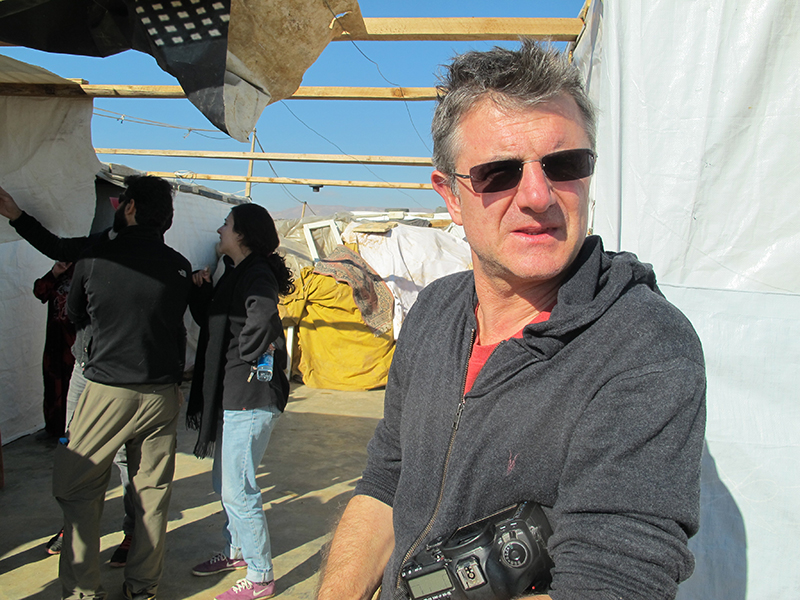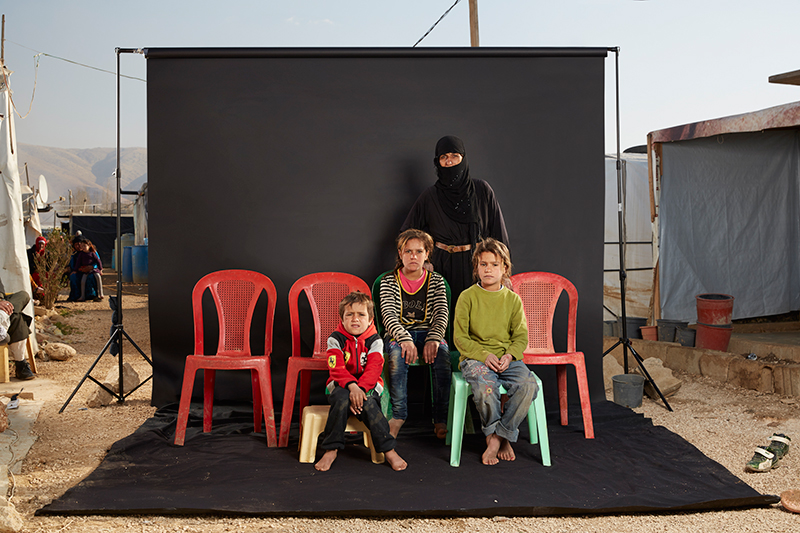Lost Family Portraits: Photographing the Syrian refugee crisis in Lebanon

Dario Mitidieri began his career as a professional photographer in 1987 working for The Sunday Telegraph and The Independent newspapers. In his long and illustrious career, he has travelled to Tiananmen Square in Beijing to witness the army repression of students. He has also photographed the conflict in Northern Ireland, the Iraq War, the 2005 Tsunami in Indonesia and the Kobe Earthquake in Japan. He recently travelled to the Bekaa valley, Lebanon, with CAFOD and creative agency M&C Saatchi where he worked on studio-styled portraits of twelve families who have fled the conflict in Syria.
It is early – just before eight, but winding through the steep hill side roads of Lebanon’s capital Beirut, there is a frenzy of building work: hotels and luxury apartments going up. This ancient, open city is alive.
Once we leave the concrete landscape behind us, the undulating hills of the Bekaa valley – Lebanon’s agricultural pulse and once the ‘breadbasket of the Roman Empire’ – come into view. Overnight there has been a first dusting of snow on the hills.
Just over the mountain ridge, some nine kilometres away is the border with Syria.
I’m heading to a Syrian refugee camp, with CAFOD and its partner, the Caritas Lebanon Migrant Centre.
Just before Christmas, I came together with CAFOD, the Caritas Lebanon Migrant Centre and the creative agency, M&C Saatchi, to work on a unique project to highlight the plight of Syrian refugees: Lost Family Portraits.
See some of the Lost Family Portraits
The idea is to take a pop-up studio and set it up in some of the camps and take family portraits of Syrian refugees, with empty chairs symbolising the loved ones they have left behind or lost due to this horrific six-year war.
Nearly 4.3 million Syrians – a fifth of the population before the war – are registered as refugees in the region which includes 1.2 million in Lebanon.
Life in the Bekaa valley
Here in the Bekaa valley, across its wide fertile plains, I see clusters of camps. A typical shelter will have a timber frame, and walls made from wire, cardboard, plywood and blankets. The outer shell is made up of plastic sheeting most common is the blue and white UN Refugee agency UNHCR plastic sheeting, but I’ve also seen discarded advertising posters weighed down with old car tyres or cement blocks. The promotions make a strange contrast with the starkness of camp life.
Our first camp. An amazing set up because we were right in the middle of the camp. I look through the viewfinder on my camera and I can see things happening around the black backdrop we’ve set up. A man sits with a stool with a hookah pipe, he looks back at me. A girl peers round the screen inquisitively – I duck down to look through the viewfinder again and can see her furrowed, curious brow. There’s noise – young men nail wood together to make a tent. There’s a race against time to pin down tarpaulin as the winter sets in. This bright sunlight is playing tricks, every once in a while there’s a reminder of how cold it can get here when the biting cold wind blows down off the Syrian mountains as if in warning.
Donate the the CAFOD Refugee Crisis Appeal
As the family members walk onto the studio, they take their shoes off. It’s a mark of respect really – they don’t know us, yet don’t want to muddy the cloth on the floor. I leave the shoes in shot because they’re a reminder that many of the families will have had to walk for days just to get to this very basic and uncompromising form of safety.
Horror stories
It is the grief and sadness that strikes me first. There in the eyes of the adults and young people. There is strength for sure, but above all, the human loss stares back at me – holding me, daring me to look away. And it makes a stark contrast to the wriggling, smiling, excited young children oblivious to the reality of their parent’s suffering.
When people look at these photographs, photos of families, just like yours and mine I would like them to react with sympathy, and with horror. The families I am meeting have been witness to so many stories – horror stories, terrible stories – people dying, children dying, things that shouldn’t be happening in the 21st century.

See more of the Lost Family Portraits
I met a father who lost his wife in a bomb attack; he is left to take care of his three traumatised daughters, the youngest clung to his arm refusing to let it go. There was another mother who looked me in the eyes and the pain she felt in leaving her child behind was plain. There is suffering, but I want to show that this is not an idea that you or I can’t comprehend. The people I am meeting are shopkeepers, mothers, farmers, taxi drivers, salesmen, builders. They are people we meet every day – people we might live with, people we might even be. Their suffering and the horror we should feel at their suffering is our suffering.
Donate the the CAFOD Refugee Crisis Appeal
Holding on to hope
One thing that the families I met have taught me is the power of hope, no matter how horrendous their stories, everyone I met held on to hope.
These stories are a reminder that we can’t forget, we can’t just switch off the TV and forget about it. These are real people with real stories, and that is why it’s very important to keep raising the issue – look at these photographs of families, read their stories. Today it’s them, tomorrow, God forbid, it could be us.
My hope is that Syria, and the whole of the Middle East finds the right path towards peace.